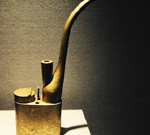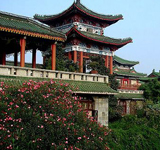| Show respect for history | ||||||||||||
|
||||||||||||
http://english.dbw.cn銆€銆€
2010-01-06 17:00:08
|
||||||||||||
|
It should be of great significance in archaeology and the study of history but its sideline benefits to the local economy have far outweighed other concerns in the discovery of an ancient tomb. Such is the controversy that has surrounded an ancient tomb recently discovered in the city of Anyang, in Central China's Henan province. The local government announced late last year that it was the burial place of Cao Cao (AD 155-220) - a renowned warlord and self-appointed imperial ruler who built the strongest and most prosperous state during the Three Kingdoms (AD 220-280) period. Some archaeologists confirmed the claim by verifying cultural relics allegedly related to the tomb. And the local government immediately sought approval from the central authorities for the tomb to be declared a site of historical interest under State protection and to start developing it as a tourist site. However, experts in both archaeology and history as well as many ordinary people have questioned the authenticity of evidence from the local government. None of the cultural relics provided are first-hand items unearthed from the tomb. Instead, they were confiscated from grave plunderers. And some experts believe that they may not have come from the tomb at all. A knock-on effect of all this is the request by authorities in Bozhou, in East China's Anhui province, where Cao Cao was born, for permission to excavate a group of ancient tombs that have long been considered the mausoleum of the ancient leader. The hastiness of the local government in Anyang to claim the tomb as Cao Cao's final resting place sends a message that it attaches much more importance to the economic benefits that the tomb may bring than to the historical significance of the discovery itself. In striking contrast was the demolition of more than 30,000 sites of historical interest nationwide during the great rush of urban renovations during the past two decades. When a landmark building from a particular period in history is in the way of urban construction, a local government will not hesitate to tear it down. Yet, when a site has a connection, no matter how far-fetched, to a historical figure whose name is likely to bring economic benefits, a government will do all it can to establish and confirm that relevance. It is not rare for some local governments to have a verbal fight over the question of which one should be the birthplace or burial site of a historical figure. Cao Cao, a household name from history whose fame comes from one of the four ancient classic novels - Romance of the Three Kingdoms - certainly means a great deal to tourism in the place where he was born or buried. Yet, archaeology is a serious matter. Verifying the significance of a tomb should not depend on its value to tourism. More first-hand cultural relics are needed and so is further assessment of the evidence by more experts in both archaeology and history before the Anyang site is declared Cao Cao's tomb. We sincerely hope that the Anyang government shows enough respect for history and archaeology in verifying the tomb's authenticity. |
||||||||||||
| Author锛? 銆€銆€銆€Source锛? xinhua 銆€銆€銆€ Editor锛? Yang Fan | ||||||||||||
 涓枃绠€浣?/a>銆€|銆€
涓枃绠€浣?/a>銆€|銆€










